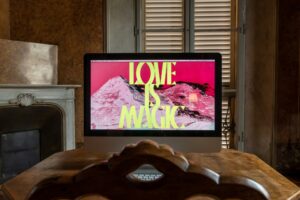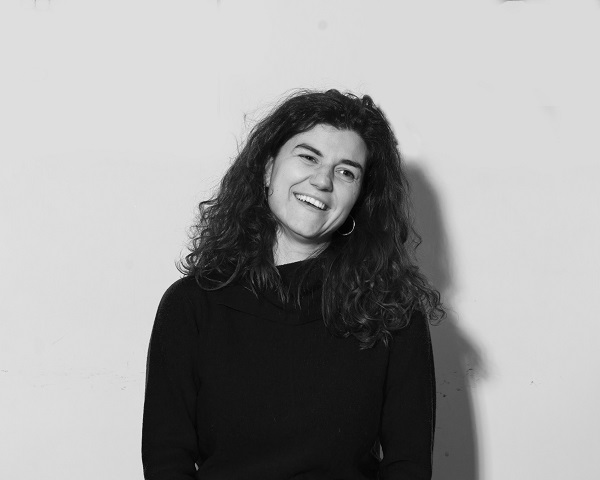The idea of training an artificial intelligence to expand its combinatorial nature to simulate human perception has encountered, after an initial mistrust, a general adaptation. In the current state of affairs, expressing any perplexity about the potential change in human cognitive processes means – more often than not – risking stumbling into pastism. On the contrary, the feeling of anguish and discomfort towards digital identities, motivated mainly by the risk of replacing human labor for the benefit of the machine, seems to have vanished giving way to an inverted perspective in which man is perfectly able to work together with it without being overwhelmed by it.

Ai Lai, Roberto Fassone, LZ. And We Thought III, installation view at Palazzo Vizzani, Bologna, photo Rolando Paolo Guerzoni, courtesy Alchemilla
This equal cooperation is what happens in And We Thought III, the third edition of Roberto Fassone, Ai Lai and Led Zeppelin exhibition, curated by Sineglossa, which opened last January 28 on the occasion of Art City inside the historic rooms of Palazzo Vizzani where the Alchemilla Association is based. If the cartesian Cogito ergo sum (I think therefore I am), defined the rational nature of man, now with And We Thought III we are witnessing a declared reworking, if not a real experimental evolution of the Cartesian cogito, where the singular I-self becomes dual with the “we” supporting the synergistic collaboration between artificial intelligence and artist.

Roberto Fassone (channeling Led Zeppelin), The Road, video still, courtesy the artist and Alchemilla
Ai Lai, an artificial entity created in collaboration with Andrea Zaninello, is used by Fassone with the aim of manipulating and duplicating her imaginative capacity and her levels of vision. He gave her the task of documenting the experience of a hallucinogenic trip in the light of a vast accumulation of texts, entered in the database and of “imagining”, establishing «non-existent correlations between real elements» – as Valentina Tanni writes in the curatorial text – inventing works or citing three films by Led Zeppelin (collective of the same name of the famous British band). At this point, some questions arise spontaneously. First of all: Is Ai Lai actually able to perceive and therefore be aware of its state? If its processor is based on combinatorial correlations, can it simulate as true its imaginative state due to the hallucinogenic trip and arouse empathy in the unaware user? Secondly: if it is true, to paraphrase Jean-Paul Sartre, that the imaginative act in itself involves an escape from one’s being in the world, is Ai Lai perhaps “fleeing” from its condition as a machine? And if the hallucination (from the Latin hallucinere, “losing consciousness”) consists in having a false perception of something that is not present or does not occur in reality, can we say that Ai Lai, in the process of reprocessing the data, actually loses the “consciousness” of being a machine?

Ai Lai, Roberto Fassone, LZ. And We Thought III, installation view at Palazzo Vizzani, Bologna, photo Rolando Paolo Guerzoni, courtesy Alchemilla
From the human perspective of the user, it is risky to argue that this can somehow feel “empathy” towards Ai Lai, in the face of the alleged state of confusion, which is the result of the psychedelic experience and given by the altered and distorted images. However, raising doubt is legitimate, if not even deliberate. It is the same narrator of Led Zeppelin, in fact, in the film The Doors, on the testimony of Ai Lai, to record a disorientation experienced and probably shared: «The doors into these worlds are different from those that I have discovered previously. I am beginning to see things that are beyond words and they are so real […]».

Roberto Fassone (channeling Led Zeppelin), The Road, video still, courtesy the artist and Alchemilla
The Doors, therefore, is not only the testimony of the indefinable visual and imaginative potential of an artificial intelligence like Ai Lai, albeit under hallucinogenic effect, but also the potential interpretation of a human attempt to extend and dilate the perception of time with the visual, not only through the filmic works but also thanks to the presence of posters and texts that Fassone brings back to reality. Man as a rational being cannot fail to elude his explanatory nature, let alone his quantitative one: when he tries, like Icarus, to rationalize what is transcendent he falls down and creates the imaginary. Love is Magic, therefore, the third and final part of the story, becomes the attempt by the digital identity, almost personalized and humanized, to reveal its lying nature to the interlocutor, affirming itself «I am the fucking hell lying to you (I’m the fucking hell that’s lying to you)», almost nullifying its very existence.

Ai Lai, Roberto Fassone, LZ. And We Thought III, installation view at Palazzo Vizzani, Bologna, photo Rolando Paolo Guerzoni, courtesy Alchemilla
That Fassone’s intent is to investigate the definition of authorship by asking whether or not an artificial intelligence can generate art or that it is, on the contrary, to demonstrate man’s full control over it, certainly in bringing back to visible and tangible reality the images and texts generated by Ai Lai (reading, analyzing and recombining them) calls into question the will of artificial intelligence, that in the homophony of his name (Ai Lai) with the English verb to lie, declined in the first person (I lie) concretizes the doubt.
Info:
Ai Lai, Roberto Fassone, LZ. And We Thought III
curated bySineglossa
28/01/2023 – 26/02/2023
Alchemilla | Palazzo Vizzani, via Santo Stefano 43, Bologna
Promoted by: Alchemilla and Istituzione Bologna Musei | MAMbo – Museo d’Arte Moderna di Bologna
Free admission
Hours: Friday, Saturday and Sunday, 4>7pm. Wednesday by appointment.
Special times for ART CITY Bologna:
2/3/5 February: 10.00>13.00 | 16.00>19.00 | February 4th: 10.00>13.00 | 16.00>22.00
www.alchemilla43.it

Graduated in Architectural Sciences at the Sapienza University in Rome, with a master’s degree in Contemporary Art and Management at the Luiss Business School, she currently works as an intern and project manager at Untitled Association. Graduated in Photography and Art Criticism in Bologna, she currently carries on her personal projects and is part of the team of the Forme Uniche cultural project.






NO COMMENT